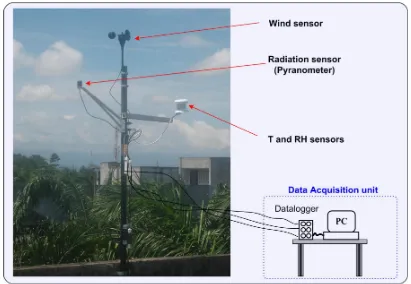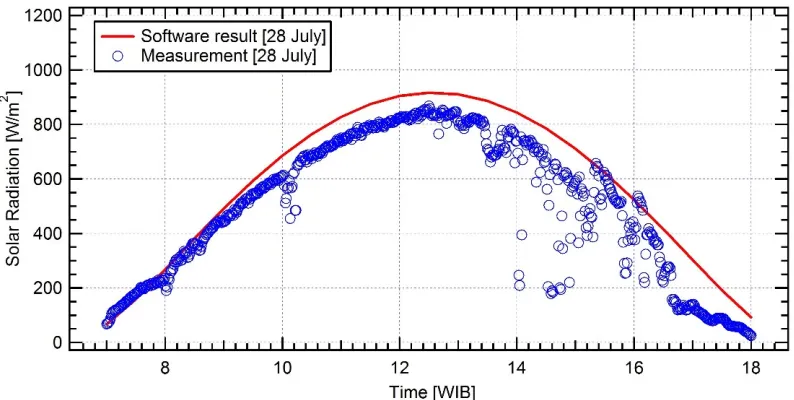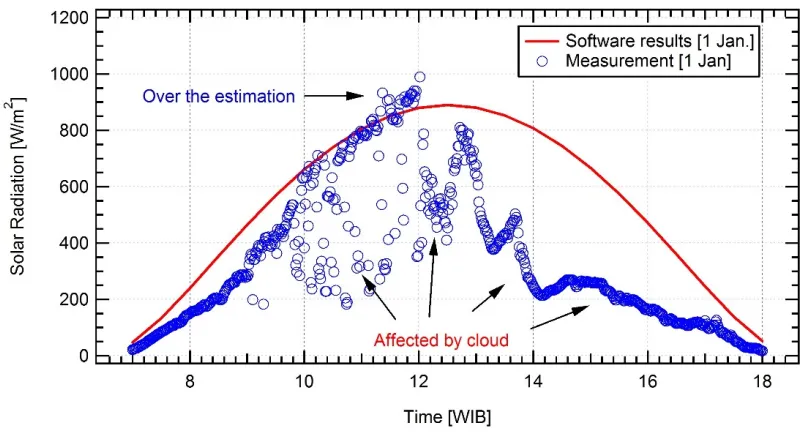Journal of Physics: Conference Series
PAPER • OPEN ACCESS
Development of software for estimating clear sky
solar radiation in Indonesia
To cite this article: H Ambarita 2017 J. Phys.: Conf. Ser.801 012093
View the article online for updates and enhancements.
Related content
Experiments and simulations on a thermosyphon solar collector with integrated storage
P Toninelli, A Mariani and D Del Col
-Astronomical and Meteorological Conditions of a Solar System Operation
Danuta Proszak- Misik, Maria Bukowska, Krzysztof Nowak et al.
-Spectral irradiance of daylight for air mass 2
C J Kok
-Recent citations
Numerical study on the effect of configuration of a simple box solar cooker for boiling waterH Ambarita
-Numerical study on the effects of absorptivity on performance of flat plate solar collector of a water heater
D R S. Tambunan et al
Development of software for estimating clear sky solar
radiation in Indonesia
H Ambarita
Sustainable Energy Research Centre, Faculty of Engineering University of Sumatera Utara, Jl. Almamater Kampus USU Medan 20155, Indonesia
*Email: himsar@usu.ac.id
Abstract. Research on solar energy applications in Indonesia has come under scrutiny in recent years. Solar radiation is harvested by solar collector or solar cell and convert the energy into useful energy such as heat and or electricity. In order to provide a better configuration of a solar collector or a solar cell, clear sky radiation should be estimated properly. In this study, an in-house software for estimating clear sky radiation is developed. The governing equations are solved simultaneously. The software is tested in Medan city by performing a solar radiation measurements. For clear sky radiation, the results of the software and measurements ones show a good agreement. However, for the cloudy sky condition it cannot predict the solar radiation. This software can be used to estimate the clear sky radiation in Indonesia.
1. Introduction
Solar energy is a potential renewable energy resource for the globe. The annual solar radiation reaching the earth surface is approximately 3,400,000 Exajoule. The annual energy consumption of human being is approximately 450 Exajoule. This fact reveals that only 1 hour 10 minutes of solar radiation can fill the global annual energy consumption. Solar energy resource will be crucial for future energy resources. In Indonesia, the potency of solar energy is very significant. According to Ministry of Mineral and Energy Resources of the Government of Indonesia, the potency of solar energy in Indonesian islands is 4.8 kWh/m2/day in average and the duration of radiation is 10 – 12 hours per day. This is a big potency
to be collected. Research on solar energy applications in Indonesia has come under scrutiny in recent years. Solar radiation is harvested by solar collector or solar cell and convert the energy into useful energy such as heat and or electricity.
Several studies on solar energy application can be found in literature. Thirugnanasambandam et al [1] reported a literature review of solar thermal technologies. According to the study all solar thermal technologies can be divided into eight groups. They are solar water heater [2], solar cooker [3], solar driers [4], solar ponds [5], solar architecture [6], solar air-conditioning [7], solar chimneys [8], solar power plants [9], and solar water purification [10]. Those studies only several examples that show that research on the use of solar energy in recent years has reached a remarkable edge. The main driving forces for this are the perceiving scarcity of fossil fuel and the global warming catastrophe. In Indonesia, there is a strong commitment from the Government of Indonesia to accelerate the research on the use of solar energy. Thus, number of reported studies on solar energy applications in Indonesia are increasing. Dina et al [11] reported a study on effectiveness of continuous solar drier integrated with desiccant thermal storage for drying cocoa beans. In this study, in day time solar energy is used as energy for
International Conference on Computing and Applied Informatics 2016 IOP Publishing
drying and to heat thermal energy storage. The thermal energy storage is then used in the night time to provide continuous drying. Ambarita and Kawai [12] reported an experimental study on solar-powered adsorption refrigeration cycle with activated alumina and activated carbon as adsorbent. Here, solar radiation is used to heat generator of the adsorption cycle. Recently, Ambarita [13] reported a study on the performance of natural vacuum desalination system using low grade heat source.
The above literatures show that the solar energy from the sky is used as energy input to the system. Mainly, the solar radiation is used to calculate the performance of the system. However, to the best knowledge of the author, there is no reported study focuses on the estimation of the solar radiation for Indonesia case found in literature. In this work, in order to estimate solar radiation on the flat surface of a solar collector, an in-house software is developed. The developed software will be validated by performing a solar radiation measurements in Medan city of Indonesia. The results are expected to supply the necessary information to support the Government of Indonesia in development of the solar collector technologies.
2. Method
In this study a software for estimating clear sky radiation is developed. The results of the developed software are validated by using measurement data in Medan city of Indonesia. Thus, governing equations used in the software and the experimental method are explained in the following sections.
2.1. Governing equations
The total clear sky radiation is the sum of beam radiation (Gbeam) and diffuse radiation (Gdifuse). The following equation is used to calculate the clear sky radiation.
total beam difuse
G =G +G (1)
The beam and diffuse radiations are calculated using the following equations: cos atmospheric transmittance for beam radiation. The zenith angle is calculated by the following equation:
δ
and ω is hour angle. The declination angle is calculated by the following equation. 284 where
L
st is the standard meridian for the local time zone andL
loc is longitude of the location. The parameterE
is the equation of time and calculated by the following equation.E=229, 2(0,000075 0,001868cos+ B−0,032077 sinB−0,014615cos 2B−0,04089sin 2B (8)
The atmospheric transmittance for beam radiation is calculated by:
2
International Conference on Computing and Applied Informatics 2016 IOP Publishing
−
The parameters a0, a1 and kin equation (10) are calculated using the following equations, respectively:
(
)
The above governing equations are solved simultaneously. Here, a Fortran code program is written to solve those governing equations. The Fortran, stand for Formula Translation, is a general purpose, imperative programming language that is especially suited to numeric computation and scientific computing.
2.2. Solar radiation measurements
In order to validate the developed software, a solar radiation measurement apparatus has been designed and fabricated and shown in Figure 1.
Figure 1. Solar radiation measurement apparatus
The apparatus is made of A HOBO micro station data logger which consists of temperature/RH smart sensor, solar radiation sensor, and wind velocity smart sensors. The solar radiation smart sensor is a light sensor (silicon pyranometer) with a measurement range of 0 to 1280 W/m2 over a spectral range
of 300 to 1100 nm. The measurement resolution and accuracy are 1.25W/m2 and ±5%, respectively. International Conference on Computing and Applied Informatics 2016 IOP Publishing
The temperature/RH smart sensor has temperature measurement range of -40oC to 75oC. The
temperature measurement and accuracy are 0.02oC (at 25oC) and ±0.21oC (from 0 to 50oC).
Measurement range of the wind velocity sensor is 0 to 76 m/sec. The measurement accuracy and resolution are ±1.1 m/s and 0.5 m/s, respectively. By using the above data acquisition unit and the smart sensors solar radiation measurements are carried out. The interval of measurement is 2 minutes.
3. Results and Discussions
Solar radiation resulted from the developed software and measurement by experimental apparatus will be presented and discussed here. The measurements take place on top roof of “Gedung S2 Teknik Mesin” of University of Sumatera Utara in Medan city of Indonesia. Several measurements have been carried out. All measurements can be divided into clear sky condition and cloudy sky condition. Thus, the results and discussions will be divided into clear sky and cloudy sky conditions as shown in the following sub sections.
3.1. Clear sky condition
For the clear sky radiation condition, the measurement and software results are presented in Figure 2. The measurements were taken from July 28 of 2015. In the figure, the software result is shown by red solid line and measurement results shown by blue circle markers. The vertical axis of the graphic shows solar radiation and the horizontal axis shows time in local time of Medan (WIB). Both measurement and software results show the same trend. In the morning time, as the sun rises solar radiation increases as time increase. In this section, the measurement starts at 7.00 WIB in the morning. The software and measurement results show almost the same value of radiation. The software and the measurement results are 66.77 W/m2 and 68.10 W/m2, respectively. For the measurement results, a maximum value of solar
radiation of 846 W/m2 is captured at 12.50 WIB. While from the software results, the maximum value
is 916.8 W/m2 at 12.50 WIB. These facts reveal that measurement and software show a different
maximum value of radiation. There is a discrepancy of 8.3%. However, the software and measurement show the same time when the maximum radiation occurs. After the maximum value is reaching, the software result and measurement show the same trend. The solar radiation decrease as time increase. In the figure, some measurement show lower values. This is because of the presence of cloud in the sky. But, the number of lower value is not significant. Based on these results, a preliminary conclusion can be drawn here. When the sky is clear, the software can predict the solar radiation. The solar radiation trend and the time of maximum value can be predicted perfectly. The maximum value shows a discrepancy only 8% or less than 10%.
Figure 2. Software and Measurement results for clear sky condition
4
International Conference on Computing and Applied Informatics 2016 IOP Publishing
3.2 Cloudy sky condition
In the measurement, there are several days are categorized cloudy sky. One of the measurement is shown in Figure 3. The figure shows the solar radiation resulted by software and by measurement on January 1st of 2015. In the figure the measurement results shown by blue circle markers and the software result
shown by solid red line. As expected, the software result shows the same trend with the previous clear sky radiation. In the morning, the radiation increase as time increase. After reaching a maximum value the solar radiation decrease as time increase. The measurement shows a different trend with the previous clear sky radiation. It is very unpredictable. It can be seen clearly that measurement and software results show different value in almost all times.
Figure 3. Software and Measurement results for cloudy sky condition on January 1st, 2015
Figure 4. Software and Measurement results for combination clear and cloudy sky conditions on
August 9th, 2015
International Conference on Computing and Applied Informatics 2016 IOP Publishing
A combination of clear sky and cloudy sky conditions is shown in Figure 4. The measurement was taken on August 9th, 2015. The figure shows that in the morning the software and measurement show the same
results. However, after the maximum value is reaching, the software and measurement show a significant different. This is because the solar radiation from the sky is blocked by the cloud.
4. Conclusions
In this study a software for estimating clear sky radiation has been developed. In the software, a set of governing equations is solved simultaneously by using a FORTRAN code. In order to validate the software an experimental apparatus has been developed and several measurements in Medan city of Indonesia have been carried. The software results and measurements have been compared. The conclusions of this study are as follows. For the clear sky condition, the software can predict the solar radiation with acceptable value. The discrepancy less than 10%. However, for the cloudy sky condition the solar radiation is very unpredictable. It is suggested that this software can be used to predict solar radiation in order to design solar collector.
References
[1]
Thirugnanasambandam M, Iniyan S, Goic R 2010 Renewable and Sutainable Energy Review14, 312-322.[2]
Mathioulakis E, Belessiotis V 2002 Solar Energy72(1) 13-20.[3]
Schwarzer K, Vieira da Silva ME, 2008 Solar Energy82 157-63.[4]
Mahapatra AK, Imre L 1997 Solar Energy59 (4-6) 227-31.[5]
Velmurugan V, Srithar K 2008 Renewable and Sustainable Energy Reviews12 2253-63.[6]
Kischkoweit-Lopin M 2002 Solar Energy73(2) 77-82.[7]
Elsafty A, Al-Daini AJ 2002 Renewable Energy5 569-83.[8]
Pretorius JP, Kroger DG 2006 Solar Energy80 534-44.[9]
Quaschning V 2004 Solar Energy77 171-8.[10]
Tripathi R, Tiwari GN 2006 Solar Energy80 956-67.[11]
Dina SF, Ambarita H, Napitupulu FH, Kawai H 2015 Cases Studies in Thermal Engineering532-40.
[12]
Ambarita H, Kawai H 2016 Cases Studies in Thermal Engineering7 36-46.[13]
Ambarita H 2016 Cases Studies in Thermal Engineering8 346-58.[14]
Hottel HC. 1976 Solar Energy18 129.
6
International Conference on Computing and Applied Informatics 2016 IOP Publishing


